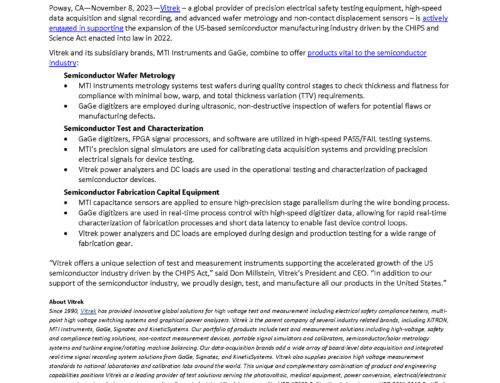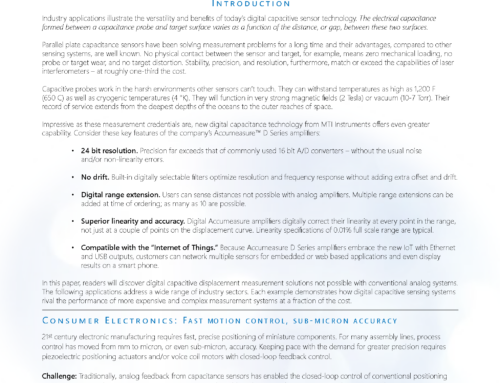Closed Loop, Non-woven Conductive Film Thickness Measurement and Control Solution
Description
Learn how to measure EV battery plate thickness with MTI’s Digital Accumeasure, a high-precision capacitance measurement system with nanometer accuracy and stability.
Problem
Lithium battery plates for electric vehicles consist of lithium ion compounds applied to either a copper plate substrate (cathode plate) or an aluminum substrate (anode plate). The plates are approximately 100-200 um thick ( .004 – .008 inch). Typically, the anode and cathode plates are calendared together with a dielectric separator to make a three-layer sandwich. The individual plates need to be checked for thickness before they are calendared together to ensure that overall battery diameter is within specifications.
MTI‚Äôs dielectric sensing probes are used for EV battery plate thickness measurements. These probes can also be used to monitor the thickness of the separator, providing QC monitoring of all three elements used in the battery’s construction.

Typical Li-Ion battery construction
Image Credit Learn Engineering
Solution
Using capacitance, there are two methods for measuring thickness. Both methods are described below.
Method 1: Measuring EV Battery Plate Thickness
Use MTI Digital Accumeasure with two single-ended probes if the substrate can be grounded. Use push-pull probes if the substrate cannot be grounded. The anode and cathode substrates are conductive.

Method 2: Measuring EV Battery Plate Thickness
Assuming a grounded roller is being used, it is possible to use a two-channel Digital Accumeasure to measure the step height of the substrate. Ch1 in this case is the surface movement of the roller, which can be in the tens of microns. Ch2 is measuring to the top of the conductive EV substrate. Ch1-Ch2 is equal to the battery substrate (plate) thickness also corrected for roller run-out.
MTI’s Digital Accumeasure has a step height function built into the software. An easy-to-use calibration program allows the user to tare on a known battery substrate thickness. Alarm limits can be set to warn the process engineer if the thickness gets out of tolerance.  It’s important that the battery substrate material is under tension while the measurement is being made and air is not entrapped between the substrate material and the roller. Additionally, for the best operation, both ends of the roller should be constrained by bearings to prevent spindle wobble.  In this case, a 4X range extension was used to give a probe gap of 1mm.

It’s also possible to measure the thickness of the dielectric separator with MTI’s Digital Accumeasure and a dielectric probe.

Click to Enlarge
Measuring the thickness of the dielectric separator for a Li-Ion battery
MTI’s Digital Accumeasure has a built-in capability to measure the thickness of non-conductive materials such as the separator used in Li-Ion batteries. A simple-to-use calibration program allows the user to calibrate to a known sample thickness directly in engineering units. Additionally, it makes little difference if the non-conductive separator move up and down in the gap as the field passes through the material; however, it’s best to keep the material at least 1/4 of the gap above the grounded return plate.



